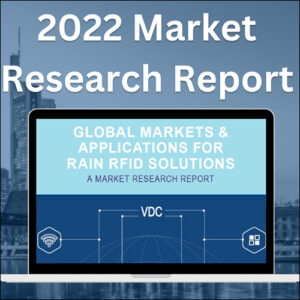- Annual 25 Percent Growth in RFID Tag Sales
- Retailer Mandates, Logistics Rollouts Are Catalysts
- Fulfillment and Pricing Challenges
- Sustainability Is Growing Focus
Dec 05, 2022Sales of radio frequency identification (RFID) tags, devices and solutions are at historic levels and rising, according to a report conducted by the RAIN Alliance and VCD Research. The study, titled "RAIN RFID Market Research Report," is the latest in a series of such studies into the UHF RFID market, and it includes sales of hardware and full solutions. The last such report, published in 2021 (see RAIN Alliance Research Finds RFID Growth Despite Pandemic), estimated that 21 billion integrated circuits (ICs) were sold worldwide in 2020, with the number growing to almost 30 billion last year. That amounts to a 36 percent increase over 2020 sales.
 Based on these results, VDC Research predicts IC shipments will rise to 88.5 billion annually by 2028, according to David Krebs, VDC's executive VP of enterprise mobility and connected devices. The current level of growth would be even higher, he says, were it not for recent global supply chain challenges, which have delayed RFID company manufacturing. Inflation may have caused some delays as well, as the cost of technology has risen globally. Despite such challenges, multiple trends have kept the growth of RFID sales steady. The two drivers are the need for businesses to improve supply chain management, as well as an interest in providing more sustainable solutions, says Aileen Ryan, the RAIN Alliance's president and CEO.
Based on these results, VDC Research predicts IC shipments will rise to 88.5 billion annually by 2028, according to David Krebs, VDC's executive VP of enterprise mobility and connected devices. The current level of growth would be even higher, he says, were it not for recent global supply chain challenges, which have delayed RFID company manufacturing. Inflation may have caused some delays as well, as the cost of technology has risen globally. Despite such challenges, multiple trends have kept the growth of RFID sales steady. The two drivers are the need for businesses to improve supply chain management, as well as an interest in providing more sustainable solutions, says Aileen Ryan, the RAIN Alliance's president and CEO.
The RAIN Alliance industry group consists of technology companies focused on the adoption and development of UHF RFID technology. VDC Research is a technology market consulting firm. This year's report, like its 2021 predecessor, included product categories such as tags and transponders, fixed readers, handheld readers, and printer-encoders. It also included multiple industries and applications, the trends within them, and growth rates according to geographic areas. The report's objective, Krebs says, was to create a piece of research that the RAIN Alliance and its members could leverage as the definitive resource related to RAIN RFID.
While other reports focus on a wider set of RFID technologies, the focus of the RAIN Alliance's research was only on passive UHF RFID. The details collected came from interviews with inlay vendors, label converters, reader and printer-encoder providers, and software solutions companies. VDC Research also used survey data previously collected from end users. "All of those components come together," Krebs states, "to provide both quantitative metrics we use for sizing the market and forecasting the market."
Annual 25 Percent Growth in RFID Tag Sales
One key takeaway for the RAIN Alliance was how much the industry is growing at a time when many technologies are more stagnant. That, in part, is due to COVID-19 having created an environment in which RFID has offered several benefits. "The pandemic actually acted as a market catalyst for RAIN RFID," Ryan says, due to the transition toward more e-commerce retail, in which product buyers expect goods to be delivered directly to them from a variety of channels, such as "buy online, pick up in store" (BOPIS).

David Krebs
The RFID technology already in use by retailers ensured they were able to better serve customers during and after the pandemic, Ryan says. "It was the ones with the strongest inventory-management systems that performed the best throughout," she explains. As more companies see value in the visibility of goods provided by RFID, the report projects a 25 percent compound annual growth between now and 2026. That growth will not all be centered around retail, she says. "We're starting to see a proliferation of new use cases," which includes manufacturing, automotive, airline baggage, pharmaceuticals and healthcare. "We're poised on the cusp of a really tremendous opportunity with a proliferation of applications across a whole variety of industries."
The pandemic has made the supply chain less predictable for retail companies, Krebs says. "We're seeing the level of unpredictability in terms of demand," he states, along with supply chain pressures. Many retailers have responded by ordering earlier, and by stocking goods ahead of predicted demand. "However, they are often making decisions based on less-than-perfect information, and the byproduct of that is creating a lot of markdowns" as retailers find themselves with excess inventory. During interviews conducted with end users, Krebs says, "What certainly came up a lot in the discussions was the need to eliminate or remove or minimize markdowns." RFID, he says, provides a tool to ensure the proper data is available for good inventory management.
Retailer Mandates, Logistics Rollouts Are Catalysts
To attain the full benefit of the technology, survey respondents indicated a need for visibility not only in the supply chain and on store shelves, but also in manufacturing and from raw material suppliers. That means the earlier the RFID tags are applied to goods in the product's life cycle, the more value they can provide. Understanding this, some retailers have issued mandates for their suppliers to provide RFID tags on goods at the point of manufacture. Examples include Nordstrom, Target and Walmart (see Walmart Recommits to RFID, Nordstrom Issues Supplier Mandate for RFID Tags, Retailer Mandates Are Like Dominoes and Walmart's RFID Mandate: A Prequel to Wider Retail Adoption).

Aileen Ryan
As suppliers began acquiring RFID technology to meet these requirements, Krebs says, "That has certainly created awareness of the technology and creates a ripple effect." He cites UPS, which has been equipping 100 facilities with RFID readers to track tagged packages to improve efficiency and avoid mis-sorts.
Of the 30 billion tag ICs sold in 2021, around 70 percent were used in apparel, footwear and other retail products. Among the other 30 percent of sales, growth rate varies from the low 20s percentage range to the 40s. The study found that growth is taking place at an accelerated rate in several sectors that, in general, are considerably smaller than the apparel market. For instance, food-based retailers, such as quick-serve restaurants, are using the technology at rates higher than 25 percent over the previous year. Automotive and pharmaceutical industry demands are also increasing at a high rate.
Despite its dominance in existing RFID tag IC sales numbers, retail apparel still has a lot of room for growth, with only about 20 percent penetration at present. That means 90 percent of apparel items are currently not tagged with RFID. Krebs says VDC Research expects growth in passive, low-cost tags to be used for cold chain or high-value electronics transportation. In this application, specialty passive tags with sensors can detect temperature, humidity or shock.
Fulfillment and Pricing Challenges
The growth comes with some obstacles as well. One of the greatest challenges currently facing the market is fulfillment, as many RFID vendors cannot fully meet the rising demand due to inconsistent access to components. RFID has also seen a rise in cost, after many years of dropping prices. For years, Krebs says, "As the volumes have increased and the manufacturing processes have improved, we found that the cost has consistently come down. That trend reversed over the last year in 2022."
Inflation results not only from supply constraints, but also from a need for higher-value tags. That's because new industries adopting RFID may require smaller volumes and higher-performing tags, such as those with higher-memory chips or greater encryption security capability. Supply availability will continue to be a challenge through 2023, Krebs predicts, adding, "It may normalize in 2024." In the meantime, technology vendors have indicated that they would have sold as much as 30 to 50 percent more RFID products had supply been fully available to meet customer demand. The costs will continue to go up before hitting a plateau in the next year, and then start to decline again.
When it comes to solution software, Krebs says, "We've seen a maturation and development of what you could classify as RFID software," though he notes that RFID technology is integrated into a variety of applications to provide full value to the RFID read data. In the past, Krebs says, users' back-end systems were not set up for the real-time information that RFID systems can provide. However, development in software is helping companies gain value from their RFID investments. "I think that there's a certain modernization that also needs to happen on the back end to really, fully take advantage of the benefits that RFID can provide."
Sustainability Is Growing Focus
While most companies contributing to the report indicated a primary concern around product availability and a reduction in markdowns due to over-supply, sustainability is growing in focus as well. "One very powerful tailwind that is highlighted in the report," Ryan states, "is sustainability with two goals: minimizing carbon emissions and minimizing waste." She cites Avery Dennison's report on supply chain waste, released in November, which indicated that $163 billion worth of inventory is discarded each year worldwide due to expiration or over-production. "That really is quite astonishing, so the opportunity for RAIN RFID to make an impact on that is also huge."
Traditionally, Krebs says, sustainability has not been a driving force in technology investment. However, he adds, "I think it is becoming increasingly important as the awareness of it has grown." There is often a disconnect between senior executives' decisions and their company's environmental, social and governance goals. The necessary alignment is starting to happen, though, motivating companies to seek sustainability tools across their enterprise. A business with high margins might not necessarily care about product waste compared against overall profit, but growing external pressure may change company priorities to focus more on sustainability in operations and supply chains.
"I would say that sustainability is not directly influencing RFID investments today as much," Krebs states, "but I think certainly it will be coming up more and more." Another impact on retailers and brands, linked to sustainability, is the trend toward reverse logistics as goods are purchased and then returned for a refund. Because of the complexity of these supply chains, as well as the volume of goods being returned, much of that product is lost to the waste stream. "There's a secondary market for sure to better manage those returns and ensure the products find their way back into sales."
The report is aimed at technology providers of all kinds, Ryan says, and is available for sale at the RAIN Alliance's website. She expects the detailed results to verify what many of these customers are seeing in the market when it comes to RFID sales. "There are very positive things happening," Ryan states.
Key Takeaways:
- UHF RFID growth is accelerating even as other markets have slowed in recent years, with 25 percent year-over-year sales increases forecasted by VDC Research.
- Challenges ahead, by way of component supply shortage and inflation, are expected to moderate in the coming year or two.

